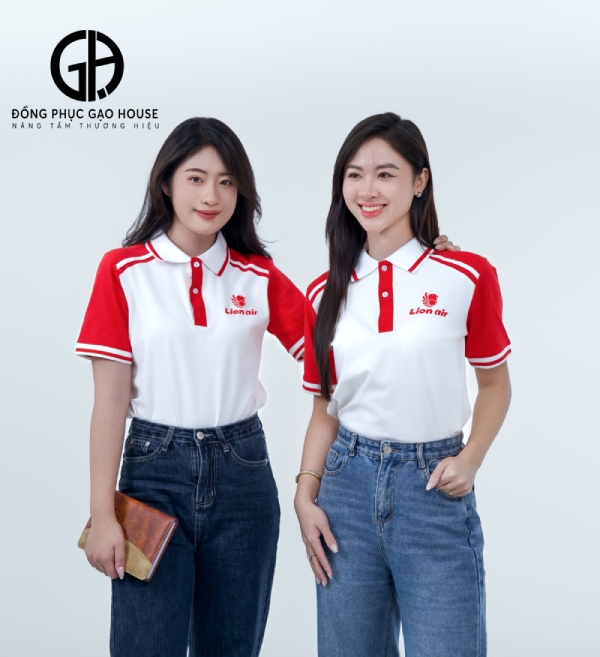cach chon ao dong phuc doanh nghiep dep
Hosted by aohocsinh
Tweet ShareHow to Choose the Ideal Corporate Uniform for Your Employees
Corporate uniforms play an essential role in your company’s overall identity. The right uniform not only fosters professionalism, but it also enhances brand recognition, improves employee morale, and ensures customer satisfaction. Reference : ao dong phuc doanh nghiep Whether you are introducing a new uniform policy or updating an existing one, selecting the right corporate uniform is a crucial decision for your business. In this article, we’ll walk you through key considerations to help you choose the ideal corporate uniform for your employees.
The Importance of Corporate Uniforms Corporate uniforms are more than just attire; they are an extension of your brand, and their significance goes far beyond just looking professional. Here are some reasons why uniforms are essential for your business:
Brand Recognition and Image A well-designed corporate uniform serves as a mobile advertisement for your business. It strengthens your brand by displaying your company’s logo, colors, and style in a uniform manner. It ensures consistency and reinforces brand recognition across different locations and among potential customers, making it easier for your clients to identify your team.
Building Trust and Credibility Employees who wear corporate uniforms are immediately recognized as part of your organization, which enhances customer trust. A professional appearance conveys competence and reliability, helping to foster a positive perception of your business in the eyes of customers, clients, and business partners.
Fostering a Positive Work Environment Uniforms help build a sense of equality and camaraderie among employees. By eliminating clothing-related distinctions, uniforms promote a culture of teamwork and inclusivity. They also allow employees to focus on their roles without worrying about what to wear each day, contributing to a more productive and harmonious work environment.
Increased Productivity A consistent dress code, such as corporate uniforms, can reduce distractions in the workplace. When employees are dressed similarly, they are less likely to compare their attire and more likely to focus on their work. Furthermore, uniforms can contribute to a streamlined and professional workplace, which leads to better performance and increased productivity.
Key Factors to Consider When Choosing Corporate Uniforms 1. Reflecting Your Brand’s Identity Your corporate uniform is a reflection of your business, and it should align with your brand values, culture, and overall image. When choosing a uniform, think about how it will represent your company to both your employees and customers.
Logo and Colors: The logo should be prominently featured on the uniform, and the design should use your brand colors. A good balance of visibility and subtlety is essential. For instance, your logo could be embroidered on the chest or sleeve, ensuring it’s noticeable without overpowering the uniform’s design.
Design Style: The design of the uniform should reflect your company’s culture. For example, a law firm might choose formal uniforms such as suits and ties, while a tech company might opt for more casual attire like branded t-shirts or polos. The uniform should embody the values of your business while maintaining a professional and cohesive look.
 2. Comfort and Functionality
Your employees will wear these uniforms for long periods, so their comfort and functionality are paramount. A comfortable uniform contributes to employee satisfaction and performance, while poorly designed clothing can lead to discomfort and frustration.
2. Comfort and Functionality
Your employees will wear these uniforms for long periods, so their comfort and functionality are paramount. A comfortable uniform contributes to employee satisfaction and performance, while poorly designed clothing can lead to discomfort and frustration.
Fabric Selection: Choose fabrics that are comfortable for long hours of wear. Cotton blends, polyester, and performance fabrics are good choices because they are breathable, durable, and easy to maintain. For active roles, moisture-wicking fabrics are ideal as they help to regulate body temperature and keep employees cool and dry.
Fit and Size Variety: Ensure that the uniforms come in a wide range of sizes and fits to accommodate different body types. Well-fitted clothing boosts confidence and makes employees feel comfortable, which enhances their overall productivity. Loose or tight clothing can create discomfort and distractions.
Practical Features: Think about the nature of your employees’ work. If they need to carry equipment or tools, adding functional features such as pockets or loops to the uniform is essential. If your team works in customer service, having a name tag or role badge on the uniform can help customers identify them easily.
- Climate and Seasonal Considerations The climate and the changing seasons will influence your uniform choices. Employees need to feel comfortable in different weather conditions, so offering seasonal uniform variations is a great option.
Summer Uniforms: During hot months, opt for lightweight and breathable fabrics like cotton, linen, or moisture-wicking blends. Short sleeves, lighter colors, and breathable materials will help your employees stay comfortable while maintaining a professional appearance.
Winter Uniforms: For colder months, consider offering additional layers such as jackets, sweaters, or scarves. Ensure that these items match the overall aesthetic of the uniform and maintain a professional appearance. Fabrics such as fleece, wool blends, and insulated materials are ideal for providing warmth without sacrificing style.
By offering seasonal variations, you’ll help your employees feel comfortable and protected throughout the year, regardless of the weather. See more : dong phuc cong so 4. Uniform Consistency Across All Roles Uniform consistency across your workforce helps maintain a professional image and ensures that all employees represent the company equally. It is essential to keep certain elements consistent, such as color scheme, fabric quality, and logo placement.
Uniform Design for Different Roles: While consistency is important, you may need to make slight adjustments depending on the nature of different job roles. For example, customer-facing employees might wear a more formal uniform, while those working behind the scenes could wear a more casual version. The key is to maintain consistency in branding and overall style.
Role-Specific Features: Consider incorporating role-specific features into the uniforms to make them more practical for each department. For example, technical staff might need uniforms with extra pockets, while safety gear such as reflective vests may be required for those working in hazardous conditions.
- Budget and Cost-Effectiveness While it's important to choose high-quality uniforms, you must also keep your budget in mind. Uniforms are an investment, so you need to find a balance between quality, durability, and cost.
Durable Materials: Choosing high-quality fabrics may involve a higher upfront cost, but it will save money in the long run. Durable materials last longer, reduce the need for frequent replacements, and stand up to regular washing.
Bulk Ordering: Ordering uniforms in bulk can significantly lower the overall cost per unit. Many suppliers offer discounts for larger orders, making bulk purchasing an excellent way to reduce costs, especially for large teams.
Maintenance Costs: Consider the maintenance and cleaning requirements of the uniforms. Choose fabrics that are machine washable and resistant to wrinkles and stains to minimize time and money spent on upkeep.
 6. Customization and Personalization
Personalizing corporate uniforms can help employees feel more connected to the company and enhance the overall customer experience. This can be as simple as adding a name tag or as intricate as fully customized designs.
6. Customization and Personalization
Personalizing corporate uniforms can help employees feel more connected to the company and enhance the overall customer experience. This can be as simple as adding a name tag or as intricate as fully customized designs.
Logo Placement: Ensure the company logo is easily visible, but not too overpowering. A discreet logo on the chest or sleeve often provides the perfect balance between professionalism and brand visibility.
Employee Names and Titles: Personalized name tags or job titles help customers and clients easily identify employees, which is especially important in customer service roles. It also helps employees take pride in their work by giving them a sense of ownership.
Unique Accessories: Adding small personalized touches, such as ties, scarves, or hats with the company logo, can further enhance the uniqueness of your corporate uniform while reinforcing your brand. See more : https://gaohouse.vn/products/ao-thun-dong-phuc-ngan-hang-shb Conclusion Choosing the ideal corporate uniform is more than just a matter of appearance; it’s a strategic decision that can influence employee performance, brand recognition, and customer satisfaction. By focusing on key factors like brand alignment, comfort, functionality, and budget, you can select a uniform that reflects your company’s values and meets your employees’ needs. A well-chosen corporate uniform not only strengthens your brand’s identity but also fosters a sense of unity among your workforce, making them feel valued and professional. Investing in the right corporate uniform is an investment in the success and image of your business.